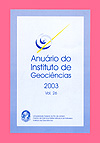Aplicações de técnicas geofísicas na parte emersa da Baía de Guanabara: uma revisão bibliográfica
DOI:
https://doi.org/10.11137/2003_0_117-126Abstract
This paper presents the application of the geophysical techniques on two investigations around of Baía de Guanabara, Rio de Janeiro. The first one was carried out in the area of the Petroflex, a petrochemical industry, located at Campos Elíseos area in the bank of the bay and the second one at Ilha do Fundão, one of the island slocated in Guanabara bay. According to Anjos et al.. (2001) the research at Petroflex area was part of the company Social Project: "Conheça seu Manguezal" (Knowing your mangrove). For this research the geophysical survey was applied within the industrial park in order to identify solid waste contamination (rubber, plastic and metal barrels). The Ground Penetrating Radar (GPR) technique was used with the RAMAC/MALA equipment. The study area consists of clay and sands deposited in marine conditions, which are frequently contaminated by salt water. In general, the GPR results obtained in both media, clay material and sediments saturated with salt water are not satisfactory. However the results obtained in the Petroflex area were good. The stratigraphic sequence in the area is the following, from top to bottom: The first bed is a clay landfill, the second bed is formed by dark marine clay, and the third bed is composed of fine-grained sand with marine shells. The surveys originated sections with average depths of 14 m and average velocity of 70 m/µs. The results showed two physical discontinuities within the second bed (marine clay), which possibly represent a Pleistocene platform exposition, described in the literature as Guanabariana Regression. It was also possible to identify anomalies within the first bed (clay landfill) represented by signal attenuation, and the others identify waste deposits, where the presence of buried drums was verified. Such work has demonstrated the success of GPR applicability even to clay soil contaminated by salt water. The Ilha do Fundão where the second investigation took place, according to Rocha et al. (1998) is the result of an artificial embankment of a former small archipelago, built in the early 1950's. The aim of this work was to identify, by means of a geoelectric survey, the cores of the original islands. Normally, structures near the seacoast cannot be detected through geoelectric measurements. This is due to the presence of salt water in sediments. However, in the Ilha do Fundão case, the high electric conductivity sediments have a lens shaped with small thickness and correspond to the embankments. This circumstance allows the detection of deep layers and resistive nuclei. Results were obtained from vertical electric soundings using Schlumberger configuration with a maximum aperture (ab/2) of 100 m. The original data was published in Rocha et al. (1998).Downloads
Download data is not yet available.
Downloads
Published
2003-01-01
How to Cite
Rocha, P. L. F. da (2003) “Aplicações de técnicas geofísicas na parte emersa da Baía de Guanabara: uma revisão bibliográfica”, Anuário do Instituto de Geociências. Rio de Janeiro, BR, 26, pp. 117–126. doi: 10.11137/2003_0_117-126.
Issue
Section
Article
License
This journal is licensed under a Creative Commons — Attribution 4.0 International — CC BY 4.0, which permits use, distribution and reproduction in any medium, provided the original work is properly cited.















